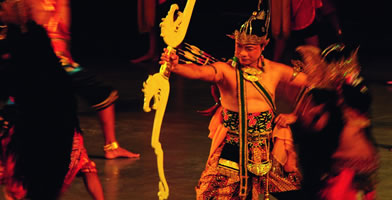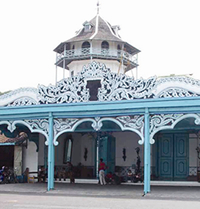Yogyakarta is a prominent historical city in central Java. It is renowned as a centre of classical Javanese fine art and culture such as batik, ballet, drama, music, poetry, and puppet shows.
Yogyakarta was the Indonesian capital during the Indonesian National Revolution from 1945 to 1949. One of the districts in Yogyakarta, Kotagede, was the capital of Mataram Sultanate between 1575-1640. Yogyakarta is the second most important tourist destination in Indonesia after Bali. Most tourists come to Yogyakarta due to its strong Javanese culture and tradition. Ramayana has been integrated into local Javanese culture, and has become the source of moral and spiritual guidance as well as aesthetic expression and entertainment.
Surakarta, often called Solo is a city in Central Java, on the eastern side of Solo lies Bengawan Solo River. The city is the seat of Surakarta Sunanate kraton (palace/court). Together with Yogyakarta, Surakarta is the heir of the Mataram Kingdom that was split into two kingdoms in 1755.
Yogyakarta is well connected from Jakarta, Bali and direct flights from Singapore and Kuala Lumpur. A two night stopover at Yogyakarta is a must to visit the famous Borobudur and Prambanan Temples.

Chandi Borobudur or Barabudur, is a Buddhist monument in Magelang, Central Java, Indonesia. The monument consists of six square platforms topped by three circular platforms, and is decorated with 2,672 relief panels and 504 Buddha statues.A main dome, located at the center of the top platform, is surrounded by 72 Buddha statues seated inside a perforated stupa. although being renovated, is still a great piece of art and architectural display, and above all the largest and the most famous temple in the world.
Built in the 9th century during the reign of the Sailendra Dynasty, the temple’s design in Gupta architecture reflects India's influence on the region, yet there are enough indigenous scenes and elements incorporated to make Borobudur uniquely Indonesian
Candi Prambanan or Loro Jonggrang Temple is a 9th century Hindu temple compound in Central Java, This magnificent Hindu temple derives it name from the village where it is located, seventeen kilometres east of Yogyakarta. Locally known as the Loro Jonggrang Temple, or the Temple of the Slender Virgin, it is the most magnificent and beautiful Hindu temple in Indonesia. Prambanan is believed to have been built by King Balitung Maha Sambu in the middle of the ninth century. Its parapets are adorned with bas-relief depicting the famous Ramayana story. It has eight shrines; the three main ones are dedicated to Shiva, Visnhu and Brahma. The main temple of Shiva rises to a height of 130 feet and houses the magnificent statue of Shiva's consort, Durga. The Ramayana ballet is performed on an open-air stage during the full moon in the months from May to October. The temple, a UNESCO World Heritage Site.


Kraton Solo or The Surakarta Hadiningrat Palace was established in 1745 by Pakubuwono II. Both of Surakarta Sunanate and Yogyakarta Sultanate are the successors of Mataram Sultanate. While Yogyakarta rulers are called sultans, the rulers of Surakarta are called as sunans.
The current Surakarta Palace of today was not completely built in 1744-45 but was built in phases to preserve its original design. Large scale building and restoration was done by Susuhunan Pakubuwono X (Sunan PB X) who ruled from 1893-1939.





